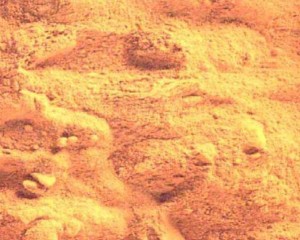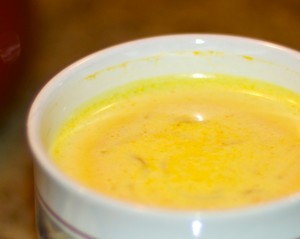Turmeric is an extraordinary herb. An orangey-yellow root that looks something like a riotous ginger, turmeric is beloved in Indian culture for its abilities to soothe the GI tract, reduce inflammation, stop bleeding and fight infection. In China, jiang huang “yellow ginger” is used to move qi and blood and to stop internal wind, which means it is a great circulatory tonic while being antispasmodic, valuable properties for arthritis indeed!
By itself turmeric is bitter, dry, spicy, and warming. Dry turmeric is more warming and somewhat less aromatic than the fresh root that I find in Indian grocery stores but both are strongly anti-inflammatory.
In the Indian pujas, turmeric powder was thrown over young brides and devas.
While much of the research on turmeric focuses on curcumin, the orange pigment, the herb itself is less irritating and gives you more for your money, especially if you mix it with black pepper which can increase absorption up to 2000%. While standardized curcumin should not be given to people with gastritis or ulcers, the herb itself protects the mucosa while addressing any infection.
Turmeric is anti-inflammatory, antioxidant, anti-infective, antibacterial and antispasmodic. It reduces cholesterol. If you cut yourself while cooking, just reach for the turmeric jar because it stops bleeding (although you will have yellowed skin for a bit.) It interferes with the ability of cancerous tumors to establish a blood supply. It is nourishing, lowers blood sugar, protects the liver, helps stimulate the bile we need to digest and is carminative, allowing better digestion. No wonder it is considered a panacea herb!
Now turmeric is actually rather bitter. In curries, where it provides both color and flavor, it tends to be about 10% of the spice masala (mix). Commercial curry powders are similar. So to get it in at medicinal dosages there are two ways that I like to use it.
The first is to make turmeric honey. Take 9 parts turmeric, enough to fill a jar about 2/3 full. Add 1 part freshly ground pepper and 1 part dry ginger and mix well. Then start stirring in a thin local honey (you can heat it over warm water to help thin it.) Stir in until you have a stiff paste. The precise amount varies depending upon weather and honey, but the point is to put in enough to slightly cover the taste while helping the assimilation with the honey. I find that it is not so sweet as to affect blood sugar. Take a heaping teaspoonful once a day.
(I gave this recipe to a friend who had lipomas as big as baseballs in her arm, and she used it faithfully each day. When I saw her six months later, the lipomas had shrunk to golf ball size, relieving a considerable amount of pain. She is still taking it.)
The second way is a traditional Indian form, turmeric milk, traditionally given when someone is coming down with a sore throat but good for all kinds of problems. While you could just add a spoonful of your turmeric honey to warm milk, here is a recipe that I adapted from Arun Shanbhag‘ s account which has lovely memories of his grandmother’s use of the drink. Take a teaspoon of turmeric and stir in a few tablespoons of water so it becomes liquid. Warm up a cup of milk on the stove. Grate a teaspoon of fresh ginger and add it to the milk and a dash of freshly ground black pepper. Let steep for 10 minutes, then stir in a teaspoon or so of brown sugar. While you can strain out the ginger and turmeric if you are taking it for culinary purposes, you might want to consume it if you are going for the herbal benefit. Here is Arun’s mouthwatering picture of turmeric milk: 
This entry is done for the August 2009 Sweet Medicine herbal blog party hosted at Kiva Rose’s website:
http://animahealingarts.org/?p=719
Good article on the anti-inflammatory benefits of curcumin at:
http://level1health.com/curcumin-from-turmeric-spice-found-to-help-fight-cancer-reduces-chronic-inflammation/
